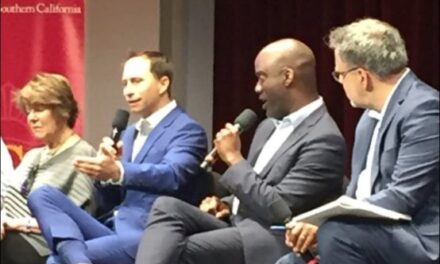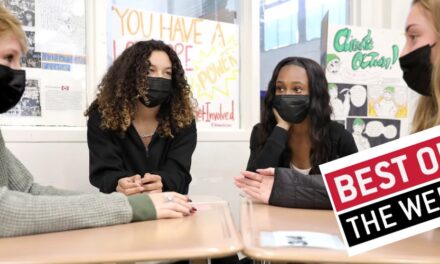A veteran journalist explores the myths surrounding suburban schools — and confronts his own complicity.
By Benjamin Herold
Back when my career as an education journalist was beginning, I avoided covering the chaotic patchwork of suburban school districts surrounding Philadelphia.
If you want me to do my job well, I remember telling an editor, I can cover the city, or I can cover the suburbs. And we both know which is more important.
I was, of course, wrong.
Suburban public schools are now the frontlines of the long-running battle to redeem America’s promise. But many of us, myself included, have been slow to the story.
Yes, we’ve written about the political battles and culture-war brawls now proliferating across suburbia. And some of the most outstanding edujournalism of recent years involved deep dives into racial divides in places like Shaker Heights, Ohio; Southlake, Texas; and suburban Maryland.
But during the four years I spent researching and writing Disillusioned: Five Families and the Unraveling of America’s Suburbs, I came to believe the conflicts in such places are really skirmishes in a much wider clash — one driven by dramatic demographic shifts and the dawning realization that endless outward expansion isn’t sustainable.
As a result, all over the country, competing versions of the American Dream are now colliding in suburbs and their schools. And how these collisions play out will depend in part on how we as journalists make sense of them.
Competing versions of the American Dream are now colliding in suburbs and their schools. And how these collisions play out will depend in part on how we as journalists make sense of them.
What caused my dramatic change in perspective?
The process began in 2015, when a series of devastating headlines began pouring out of Penn Hills, the aging inner-ring suburb east of Pittsburgh, PA, where I grew up.
After running up a staggering $172 million debt by making a series of disastrous decisions during the construction of two new school buildings, the school district that had once served my white family so well was suddenly on the verge of collapse. Teachers were furloughed, services slashed, programs eliminated. Property taxes skyrocketed. Home values stagnated. A grand jury concluded the “catastrophic” fallout would cast a pall over my hometown for “literally decades to come.”
And underlying all the woe was a seismic demographic shift: The Penn Hills public schools, 72 percent white when I’d graduated back in 1994, were now 63 percent Black. That meant thousands of parents of color had come to suburbia in search of their own American dreams, only to discover they’d been left to pick up the tab for all the opportunities families like mine had already extracted.
Among them was Bethany Smith, an African American mom I met shortly after she bought the house three doors down from my childhood home, just as Penn Hills was starting to spiral.
Suburbia’s racial Ponzi scheme
My new book Disillusioned, which comes out tomorrow, follows five families as they navigate suburban public school systems outside Atlanta, Chicago, Dallas, Los Angeles, and Pittsburgh.
During my reporting, I faced all the familiar hurdles to covering suburbia.
Pennsylvania was dotted with hundreds of small school districts, while Georgia was home to mammoth countywide districts among the largest in the nation. Existing coverage of Lovejoy ISD north of Dallas was extremely spotty, a result of local news outlets focusing the bulk of their resources and attention elsewhere. And like many suburban school systems, District 65 in Evanston, Ill. often seemed deeply uncomfortable with outside scrutiny, refusing me classroom access for well over a year.
Given the challenges, I came to greatly admire and appreciate the suburban schools coverage that education reporters produced. I learned about the history and operations of District 65, for example, largely by diving into the archives of the Evanston RoundTable, a small nonprofit that punches well above its weight. And in Penn Hills, I closely followed the work of Pittsburgh Tribune-Review reporter Michael DiVittorio, whose X bio – “covers everything but sports.” – neatly sums up the enormity of his reporting duties.
But too often, even the best suburban education stories feel disconnected from any larger narratives about America.
Too often, even the best suburban education stories feel disconnected from any larger narratives about America.
That’s where I hope Disillusioned can help.
One of the book’s central arguments is that thousands of post-war suburbs are caught up in different stages of the same cycle.
The first few generations of residents in these communities, mostly white, are lavished with guaranteed mortgages, massive tax breaks, and heavily subsidized new infrastructure, including public schools they get decades to mold in their own image. After erecting barriers to keep everyone else out, these residents reap the ensuing bounty undisturbed, all while pushing its true costs off on to future generations. Then, just before the bills come due, these families move on.
All too often, that leaves the Black, Brown, poor, and immigrant families who fought to access suburbia’s generous social contract face-to-face with a sickening realization: they’ve been stuck with the bill for all the opportunities other families already extracted.
But even after I began researching Disillusioned full-time, I didn’t recognize this pattern for well over a year.
Even after I began researching Disillusioned full-time, I didn’t recognize this pattern for well over a year.
My first breakthrough came when I decided to widen my lens and commit to examining the larger context in which suburban public schools operate.
My work grew dramatically more rigorous, for example, when I began studying comprehensive master plans. Suddenly, I had a window into the history of each community’s housing market, economy, infrastructure, social services, and land-use patterns, as well as their schools, allowing me to clearly see who each community was built for and how its institutions reflected those people’s values and interests.
Around the same time, I also began systematically examining the demographic shifts transforming suburbia.
I’m hardly the first to recognize the importance of such changes; this 2021 piece for NBC News by Tyler Kingkade and Nigel Chiwaya, for example, found that attacks on K-12 diversity, equity, and inclusion initiatives tended to occur in school districts, often suburban, whose racial makeup was changing most dramatically.
But what focusing on such shifts allowed me to see was how many suburban communities are now in the midst of a cycle that often plays out over multiple generations and huge metropolitan areas.

Above: Benjamin Herold and his book “Disillusioned.”
Take, for example, Gwinnett County. Only after I learned that the local population had gone from 90 percent white in 1990 to two-thirds nonwhite three decades later, and that neighboring DeKalb County had undergone a similar transformation a generation earlier, did I fully understand the weight of quotes like this.
“Quite frankly, the idea of tossing out three elected board members all at once does keep me up at night,” I was told during Gwinnett’s tumultuous 2020 school board elections by 82-year-old Mary Kay Murphy, one of several older white incumbents fending off challenges from younger progressives of color.
“We’ve seen here in metropolitan Atlanta some of the dysfunction that can happen.”
Scrutinizing my own white identity
Ultimately, however, it wasn’t until Bethany Smith, the mom who now lives on my old street, flipped the standard journalist-subject relationship upside-down that I finally grasped the significance of the devastating cycle now sweeping through suburbia.
The shift started slowly, with our conversations growing more stilted over the course of several months. Then, during a phone interview shortly after I’d observed her son’s 2nd grade classroom, the tensions came to a head.
“All right, let me be transparent,” Bethany told me. “I enjoy talking to you, and I’m all for what you’re doing. But there has been a long history of white people telling Black people’s stories and profiting off of it. That right there is what I’m having an issue with.”
Suddenly, it was my story, my choices, and my racial identity under the microscope. As a result, I could no longer pretend it was enough to pay my familiar detached-intellectual lip service to the many ways I was implicated in Penn Hills’ problems.
Suddenly, it was my story, my choices, and my racial identity under the microscope.
The self-analysis that ensued quickly came to include the earliest stages of my development as a journalist and writer.
Back when I was a third grader in Penn Hills, for example, I developed the annoying habit of drawing on classroom furniture after I finished my work. Rather than punish me, Ms. Bauman, white like me, brought in her typewriter from home and turned me loose. The result was my first newspaper gig, as publisher of ‘Up To Date With Room 38.’
And a couple years later, I was selected to attend a districtwide Authors Day event, where I got caught stealing money from a purse. Sweat pooled on my skinny arms as I prepared a full confession. Before I could open my mouth, however, something astonishing happened. You have a bright future, I was told by the white adults who pulled me into the hallway. Don’t screw it up. Then they ushered me back into the writing workshop. It wasn’t long before I was being tapped to help write a heartwarming A1 feature about student teachers for my elementary school’s newspaper, The Dible Scoop.
When Bethany’s challenge forced me to reconsider these incidents decades later, I initially felt the same urge toward silence that had overcome me as a boy. Best not to scrutinize the grace and opportunities that flowed my way, because who knew where the ensuing questions might lead; if my A1 feature for the Dible Scoop was a product of unearned racial advantage, what might that say about the scholarships, job offers, awards, and book deal that had come my way since?
I initially felt the same urge toward silence that had overcome me as a boy.
But instead, I decided to write those moments into Disillusioned, beginning the slow process of disarming the racial defense mechanisms that I’d first internalized while growing up white in suburbia.
As a result, the stories of parents like the Robinsons, a middle-class Black family outside Atlanta at their wits’ end over the harsh punishments their son receives for such infractions as tapping his pencil too loudly in class, gained a depth and dimension that I’d previously been missing.
Eventually, I also found a way to finish telling the story of Penn Hills that I hope will prove as nuanced, complicated, multi-dimensional, and fraught as suburbia itself.
I invited Bethany to tell her side of the story, in her own words, for compensation, as the Epilogue to Disillusioned.
And she absolutely crushed it.
Benjamin Herold is the author of Disillusioned: Five Families and the Unraveling of America’s Suburbs, to be published by Penguin Press on January 23, 2024. His award-winning beat reporting, feature writing, and investigative exposés have appeared in Education Week, PBS NewsHour, NPR, the Hechinger Report, and the Philadelphia Public School Notebook. Learn more at benjaminherold.com.
More from The Grade:
When more education coverage isn’t better
‘America to Me’ highlights the need to deepen school integration coverage
Making education journalism more accessible and inclusive
ABOUT THE AUTHOR

The Grade
Launched in 2015, The Grade is a journalist-run effort to encourage high-quality coverage of K-12 education issues.















